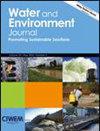Enhancing textile wastewater sustainability through calcium hypochlorite oxidation and subsequent filtration with assistance from waste blast furnace iron slag
IF 1.8
4区 环境科学与生态学
Q4 ENVIRONMENTAL SCIENCES
引用次数: 0
Abstract
The textile industry is vital to Bangladesh's economy, employing over three million women and being the top foreign exchange earner. However, it severely impacts the environment because of untreated wastewater discharge. High treatment costs, reliant on expensive imported chemicals, worsen the issue. The Environmental Conservation Rules (ECR) 2023 of Bangladesh requires textile wastewater discharge to have a colour of less than 150 Pt‐Co, which current systems struggle to meet affordably. A pilot project tested a sustainable solution using chemical oxidation with calcium hypochlorite and sand filtration with blast furnace iron slag. This method effectively removed colour, and the treated water showed total dissolved solids (TDS) levels of 157 ± 4 mg/L, total suspended solids (TSS) levels of 8 ± 2 mg/L and chemical oxygen demand (COD) levels of 9 ± 3 mg/L, with reductions of 92%, 87% and 94%, respectively, making it a viable solution for resource‐limited economies.在废高炉铁渣的帮助下,通过次氯酸钙氧化和后续过滤提高纺织废水的可持续性
纺织业对孟加拉国的经济至关重要,它雇用了 300 多万名妇女,是赚取外汇最多的行业。然而,由于未经处理的废水排放,该行业严重影响了环境。依靠昂贵的进口化学品,高昂的处理成本使问题更加严重。孟加拉国《2023 年环境保护规则》(ECR)要求纺织废水排放的色度必须低于 150 Pt-Co,而目前的系统难以经济地满足这一要求。一个试点项目测试了一种使用次氯酸钙化学氧化和高炉铁渣砂滤的可持续解决方案。这种方法能有效去除颜色,处理后的水显示总溶解固体(TDS)水平为 157 ± 4 mg/L,总悬浮固体(TSS)水平为 8 ± 2 mg/L,化学需氧量(COD)水平为 9 ± 3 mg/L,分别降低了 92%、87% 和 94%,使其成为资源有限经济体的可行解决方案。
本文章由计算机程序翻译,如有差异,请以英文原文为准。
求助全文
约1分钟内获得全文
求助全文
来源期刊

Water and Environment Journal
环境科学-湖沼学
CiteScore
4.80
自引率
0.00%
发文量
67
审稿时长
18-36 weeks
期刊介绍:
Water and Environment Journal is an internationally recognised peer reviewed Journal for the dissemination of innovations and solutions focussed on enhancing water management best practice. Water and Environment Journal is available to over 12,000 institutions with a further 7,000 copies physically distributed to the Chartered Institution of Water and Environmental Management (CIWEM) membership, comprised of environment sector professionals based across the value chain (utilities, consultancy, technology suppliers, regulators, government and NGOs). As such, the journal provides a conduit between academics and practitioners. We therefore particularly encourage contributions focussed at the interface between academia and industry, which deliver industrially impactful applied research underpinned by scientific evidence. We are keen to attract papers on a broad range of subjects including:
-Water and wastewater treatment for agricultural, municipal and industrial applications
-Sludge treatment including processing, storage and management
-Water recycling
-Urban and stormwater management
-Integrated water management strategies
-Water infrastructure and distribution
-Climate change mitigation including management of impacts on agriculture, urban areas and infrastructure
 求助内容:
求助内容: 应助结果提醒方式:
应助结果提醒方式:


